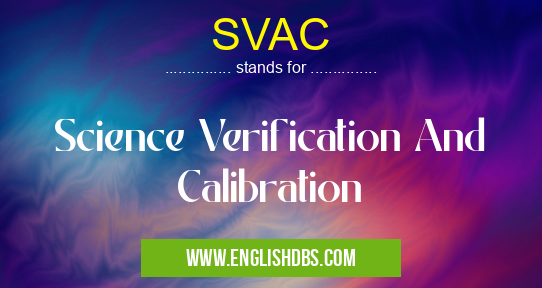What does SVAC mean in ACADEMIC & SCIENCE
SVAC stands for Science Verification And Calibration. It is a crucial phase in the development of any scientific instrument or spacecraft, where scientists and engineers thoroughly test and calibrate the instrument to ensure it meets the required performance specifications.

SVAC meaning in Academic & Science in Academic & Science
SVAC mostly used in an acronym Academic & Science in Category Academic & Science that means Science Verification And Calibration
Shorthand: SVAC,
Full Form: Science Verification And Calibration
For more information of "Science Verification And Calibration", see the section below.
SVAC Process
SVAC typically involves the following steps:
- Pre-Launch Testing: The instrument is subjected to a series of tests to verify its functionality and performance under simulated space conditions.
- On-Orbit Calibration: Once the instrument is deployed in space, it undergoes further calibration and validation using measurements of known astronomical objects.
- Data Analysis and Interpretation: Scientists analyze the SVAC data to assess the accuracy, precision, and reliability of the instrument. Based on the results, they may make adjustments or fine-tune the instrument's parameters.
Importance of SVAC
SVAC is essential for the success of any scientific mission. It ensures that the instrument:
- Produces accurate and reliable data
- Meets the science requirements of the mission
- Can withstand the harsh environment of space
Essential Questions and Answers on Science Verification And Calibration in "SCIENCE»SCIENCE"
What is Science Verification and Calibration (SVAC)?
SVAC refers to the process of verifying and calibrating scientific instruments and data before they are used for scientific research. It involves testing the instruments to ensure they are performing as expected and making adjustments to correct any errors or biases.
Why is SVAC important?
SVAC is crucial because it ensures the accuracy and reliability of scientific data. Properly calibrated instruments provide accurate measurements, which are essential for making sound scientific conclusions and advancing our understanding of the world.
What are the typical steps involved in SVAC?
SVAC typically involves the following steps:
- Characterizing the instrument: Establishing the instrument's specifications and performance parameters.
- Testing the instrument: Conducting controlled experiments or simulations to evaluate the instrument's accuracy, precision, and response.
- Adjusting the instrument: Making adjustments to the instrument's settings or calibration parameters to bring it within acceptable performance ranges.
- Validating the calibration: Verifying the instrument's calibration through independent measurements or comparisons with known standards.
Who performs SVAC?
SVAC is typically conducted by scientists, engineers, and technicians who specialize in instrument design, calibration, and data analysis. In some cases, instrument manufacturers may also provide SVAC services.
How long does SVAC typically take?
The time required for SVAC varies depending on the complexity of the instrument and the required level of accuracy. It can range from a few weeks to several months or even years for complex instruments or experiments.
Final Words: SVAC is a critical phase that helps scientists and engineers verify and calibrate scientific instruments. It ensures that the data collected by the instrument is of high quality and meets the requirements of the scientific mission. By thoroughly testing and calibrating the instrument, SVAC contributes to the success and accuracy of scientific research.
SVAC also stands for: |
|
| All stands for SVAC |
